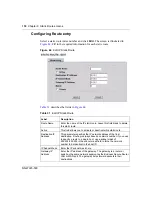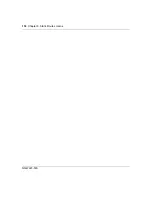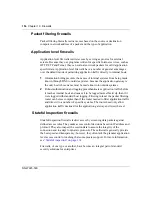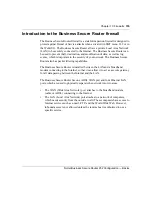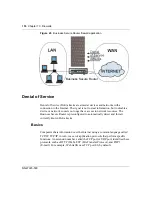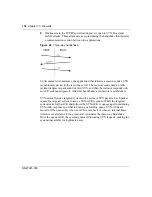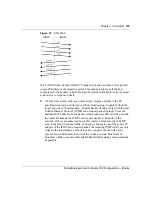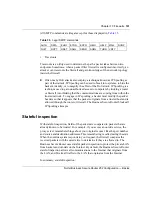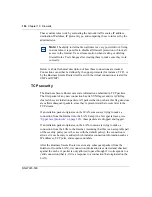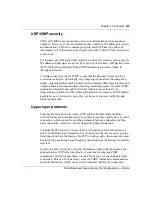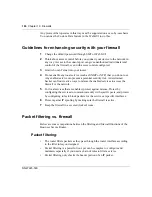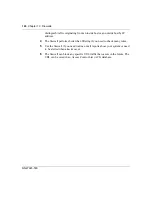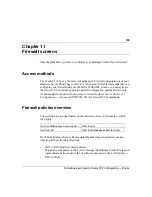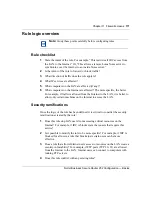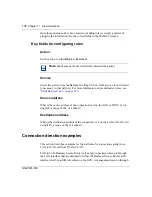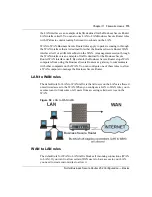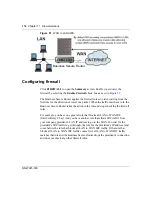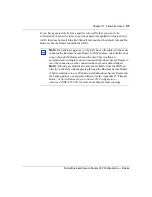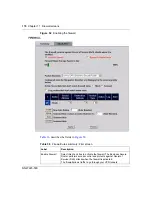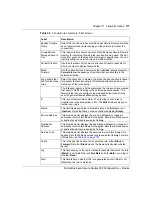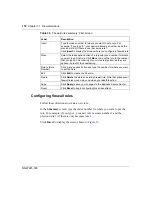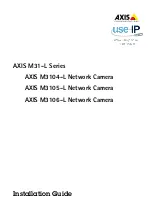
164
Chapter 10 Firewalls
NN47923-500
These custom rules work by evaluating the network traffic source IP address,
destination IP address, IP protocol type, and comparing these to rules set by the
administrator.
Below is a brief technical description of how these connections are tracked.
Connections can either be defined by the upper protocols (for instance, TCP), or
by the Business Secure Router itself (as with the virtual connections created for
UDP and ICMP).
TCP security
The Business Secure Router uses state information embedded in TCP packets.
The first packet of any new connection has its SYN flag set and its ACK flag
cleared; these are initiation packets. All packets that do not have this flag structure
are called subsequent packets, since they represent data that occurs later in the
TCP stream.
If an initiation packet originates on the WAN, someone is trying to make a
connection from the Internet into the LAN. Except in a few special cases, (see
“Upper layer protocols” on page 165
), these packets are dropped and logged.
If an initiation packet originates on the LAN, someone is trying to make a
connection from the LAN to the Internet. Assuming that this is an acceptable part
of the security policy (as is the case with the default policy), the connection is
allowed. A cache entry is added, which includes connection information such as
IP addresses, TCP ports, and sequence numbers.
After the Business Secure Router receives any subsequent packet (from the
Internet or from the LAN), its connection information is extracted and checked
against the cache. A packet is only allowed to pass through if it corresponds to a
valid connection (that is, if it is a response to a connection that originated on the
LAN).
Note:
The ability to define firewall rules is a very powerful tool. Using
custom rules, it is possible to disable all firewall protection or block all
access to the Internet. Use extreme caution when creating or deleting
firewall rules. Test changes after creating them to make sure they work
correctly.
Summary of Contents for BSR252
Page 28: ...28 Tables NN47923 500 ...
Page 44: ...44 Chapter 1 Getting to know your Business Secure Router NN47923 500 ...
Page 52: ...52 Chapter 2 Introducing the WebGUI NN47923 500 ...
Page 70: ...70 Chapter 3 Wizard setup NN47923 500 ...
Page 96: ...96 Chapter 5 System screens NN47923 500 ...
Page 114: ...114 Chapter 7 WAN screens NN47923 500 Figure 27 WAN IP ...
Page 120: ...120 Chapter 7 WAN screens NN47923 500 Figure 31 Dial Backup Setup ...
Page 128: ...128 Chapter 7 WAN screens NN47923 500 ...
Page 152: ...152 Chapter 9 Static Route screens NN47923 500 ...
Page 194: ...194 Chapter 11 Firewall screens NN47923 500 ...
Page 210: ...210 Chapter 13 VPN NN47923 500 Figure 67 Summary IP Policies ...
Page 222: ...222 Chapter 13 VPN NN47923 500 Figure 71 VPN Branch Office rule setup ...
Page 256: ...256 Chapter 13 VPN NN47923 500 Figure 81 VPN Client Termination advanced ...
Page 260: ...260 Chapter 13 VPN NN47923 500 ...
Page 264: ...264 Chapter 14 Certificates NN47923 500 Figure 83 My Certificates ...
Page 270: ...270 Chapter 14 Certificates NN47923 500 Figure 85 My Certificate create ...
Page 274: ...274 Chapter 14 Certificates NN47923 500 Figure 86 My Certificate details ...
Page 282: ...282 Chapter 14 Certificates NN47923 500 Figure 89 Trusted CA details ...
Page 298: ...298 Chapter 14 Certificates NN47923 500 ...
Page 316: ...316 Chapter 16 IEEE 802 1x NN47923 500 ...
Page 320: ...320 Chapter 17 Authentication server NN47923 500 Figure 106 Local User database edit ...
Page 328: ...328 Chapter 17 Authentication server NN47923 500 ...
Page 376: ...376 Chapter 20 Logs Screens NN47923 500 Figure 150 Log settings ...
Page 386: ...386 Chapter 20 Logs Screens NN47923 500 ...
Page 393: ...Chapter 21 Call scheduling screens 393 Nortel Business Secure Router 252 Configuration Basics ...
Page 394: ...394 Chapter 21 Call scheduling screens NN47923 500 ...
Page 410: ...410 Chapter 22 Maintenance NN47923 500 ...

